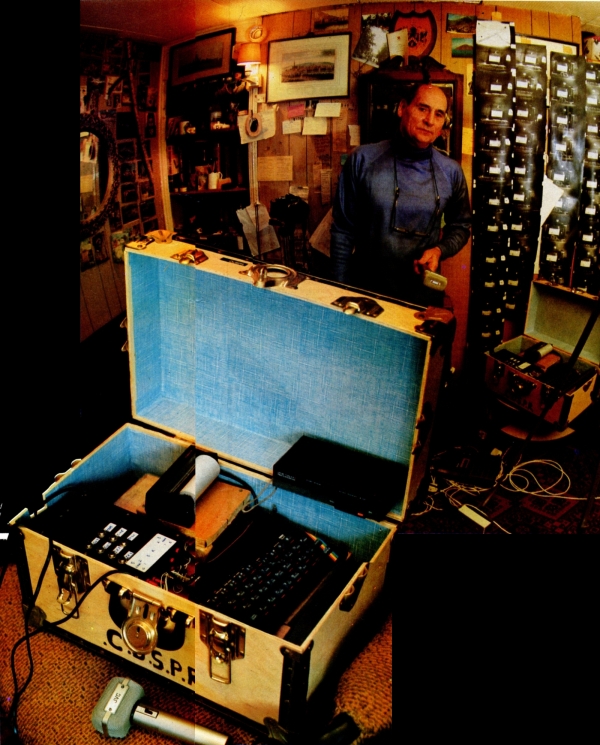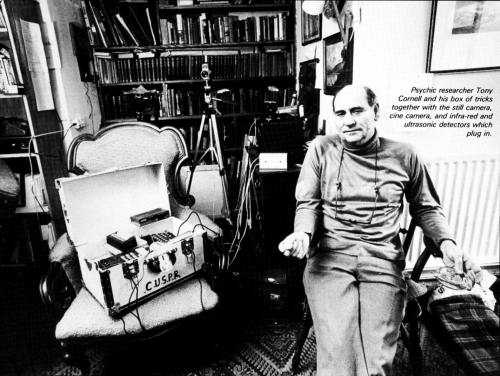
Ghoulies and ghosties and long-leggety beasties and things that go bump in the night - smile please for the cameras of Captain Spectre and his Spectrum-powered Spook hunt. Meirion Jones joins the chase
Beneath the streets of Cambridge he waits for the call. A spear hangs from the ceiling, a sword from the wall. Any moment the red phone could ring and send Captain Spectre's Flying Squad and their electronic ghost trap out on the trail of another ghoul.
The scene sounds straight out of The Avengers but Captain Spectre's quarry is more elusive than any that Emma Peel or John Steed tracked down. His mission is to capture for the first time on film denizens of another world - spirits, poltergeists, ghosts. His only weapon is a 16K Spectrum linked to an array of sensors, lights, recorders and cameras.
Captain Spectre - or Tony Cornell as he would rather be known - is fully aware of the problems of capturing spirits on celluloid. As Treasurer of the Society for Psychical Research he has been able to leaf through the thousands of supposed ghost photographs sent to the SPR since it was set up a century ago to investigate paranormal phenomena. He believes that there is "not one photographs in the archives that we would today accept as genuine".
Traditional methods of investigating haunted houses or poltergeists, are unlikely to produce scientifically acceptable results. An observer who has been left for the night in some gothic manor is quite likely to be seeing things by the early hours of the morning whether they are there or not and if anything should happen the observers may not be able to turn on recorders or take a photograph in time.
An automatic observation station with cameras and recorders that can be instantly triggered by movement, temperature changes or sound and can be left to monitor a site for days at a time is far more likely to produce useful results. It is also less likely to be taken in by the many deliberate frauds and practical jokes which have often taken in investigators of the paranormal. Sherlock Holmes's creator Sir Arthur Conan Doyle who joined the SPR after pushing his all-seeing detective off the Reichenbach Falls remained convinced to the end of his life by a film purporting to show fairies dancing at the bottom of his garden. Last month - sixty years later - one of the fairies, Mrs. Elsie Hill, finally admitted that it had all been a hoax.
Alan Cornell's first investigation of a poltergeist convinced him of the dangers of taking things at their face values. He had gone to an eerie-looking Victorian house in North London where a mysterious crashing and banging noise in empty rooms had convinced a family that the house was haunted. The father, mother and children had all moved out leaving only Grandad who refused to be scared off. On the evening that Cornell called in the old man was sitting in a corner by the fireplace. Cornell sat down and shortly afterwards he heard "thumps and bumps and crashes and bangs upstairs". A check of the upstairs room yielded no clues - there was nobody else in the house apart from the old man downstairs in his armchair. When the noise started again Cornell noticed out of the corner of his eye that Grandad was moving his shoulder.

"He had connected up two wooden balls and a heavy piece of lead under the floorboards upstairs to the old Victorian bell pull which had been used to call the servants". I asked him why he had pretended that the house was haunted. He said he had lived in the house for years and now he was old his family were planning to send him to an old people's home. It was a question of either they went or he went."
That was 25 years ago and Cornell has exposed many other frauds since - and not only in Britain. One of the strangest cases was a Dr. Richards in America who claimed that inanimate objects in his fish tank were moving of their own volition and that he had film to prove it. At first glance his film was impressive but Cornell was able to duplicate the effect using standard animation techniques - shooting the film frame by frame and then moving the objects very slighty inbetween shots.
Dr. Richards then claimed that if a question in a self-addressed envelope was placed in the tank, the spirits would answer it and return it through the U.S. mail. Using rubber gloves Cornell carefully prepared his question sheet and sent it to Dr. Richards. Sure enough the answer came back through the post, but when fingerprint powder was dusted over the sheet, it revealed that Dr. Richards' spirits had human finger and palm prints.
Although Cornell soon realised that automatic continuous surveillance equipment would make psychic research much easier, until recently the cost of such a system would have been prohibitive. Cheap home computers changed all that. The box of tricks at the heart of Cornell's monitoring system contains a 16K Spectrum, a Sinclair printer, a DCP Interspec, and a series of relays. An array of sensors can be connected up to the box. These include two infra-red beams and a doppler-shift ultrasonic alarm to detect movement, circuit-breakers to detect small movements, and sensors which can be triggered by noise or sudden changes in temperature.
The Spectrum is programmed to monitor all these inputs and to respond. If a sensor is triggered the Spectrum turns on lights and runs a cinecamera for twenty seconds. It also turns on a tape recorder for one minute and takes six still photographs with a motor-driven camera. The program also helps set up the equipment by checking through stage by stage with the operator that everything has been correctly connected. The Spectrum prints out a record of what responses were triggered and when. Once it has been set up, the equipment can function for several days without attention.
The first text for the new box of tricks came this Christmas. A 200 year-old chest of drawers in an antiques warehouse had been at the centre of some strange happenings. For weeks every morning when the staff came in the drawers would be hanging out at strange angles, even though they had been pushed in when the staff had locked up the night before. Eventually Tony Cornell was called in. He and the Cambridge University Society for PSychical Research, CUSPR, staked out the storeroom the chest was in with their box of tricks. The response was triggered eight times but the drawers had not moved and there was nothing unusual on the film. The equipment may have been triggered by a spike in the mains current so a mains smoother has subsequently been fitted. Since then there have been no further strange happenings with the chest which now sits uncomfortably in Tony Cornell's basement with two tribal sculptures eyeing it suspiciously from across the room.
Cornell is cynical about haunted houses - he believes that ghosts may be in the eyes of the beholders once they have been told that a particular place has a spooky reputation. Once he and several members of the SPR were invited to the Ferryboat Inn in Huntingdon to witness an apparition by the White Lady who was supposed to appear every March 17. "The landlord gave us dinner; there were hundreds of sightseers, Americans, everything. No-one had ever seen the White Lady - it was terrible. Some months later I saw it in a Sunday magazine described as 'The fifth most haunted house in Britain'."
Because of his own experience he is less cynical about poltergeists. At Hanneth Hall in Wisbech, Cambridgeshire, he was among a team of investigators who tore the place apart looking for any normal explanation of the bumps and thumps and objects flying around which they experienced there.
At one time it was thought that such effects might be caused by vibration perhaps from underground streams or seismic activity. Cornell's own experiments convinced him that was not the case. He obtained permission to subject four cottages which were scheduled for demolition to intense vibration. Although the tests were continued to the point when the cottages were about to collapse, they were unable to duplicate the effects attributed to poltergeists.
Spectrum telepathy
Richard Loosemoore, who built Cornell's box of tricks for just over £200 - the cameras and sensors are borrowed as and when necessary - is hoping to use a 48K Spectrum for more psychic research. He is conducting research into Artificial Intelligence - in particular cognitive psychology. But his own interest is telepathy. He believes that "there is no question about the proof of telepathy - it is just a question of what the mechanism is."
In Loosemoore's experiments two volunteers sit in separate rooms and one attempts to transmit his or her emotional state - agitation, relaxation or anxiety - to the other by telepathy. Using the same principle as a lie detector, the observers measure the Galvanic Skin Response - changes in skin conductivity - of both volunteers. If they really are able to transmit emotions by telepathy then the observers should be able to detect simultaneous changes in the GSRs of both volunteers.
In the past Loosemoore has had to borrow expensive purpose-built machines when he can to process and evaluate the data. The CUSPR has now given him £300 which he hopes will allow him to build a new system around a 48K Spectrum which will make it possible to carry out far more tests.
Tony Cornell has found the recent publicity for his investigations of the paranormal to be a mixed blessing. He never knows who is going to be on the other end of the line when the red phone goes. "I could be called out by two raving nutters - there is a lot of cranky stuff in this field." The shelves of Cornell's basement contain everything from Nostradamus's prophecies of doom and destruction to Eric von Daniken's tales of prehistoric spacemen.
Cornell suspects that "some as yet little known human faculty" may be responsible for psychic phenomena. His failure to catch a spirit red-handed opening the 200-year-old chest of drawers has not led him to believe that the spirits have something against being photographed. "After all," he says, sounding more like a social worker than a psychic researcher, "they are only doing it to draw attention to themselves."
This article was originally published in Your Computer 3.05.


 30th October 2010
30th October 2010